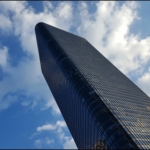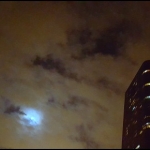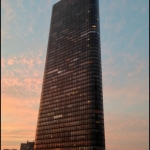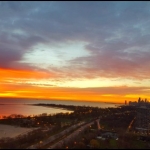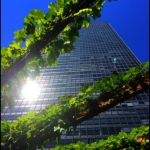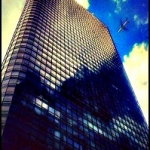Episode 7a – The Roaring Twenties, Part One (unedited)
August 9, 2019
EPISODE 7
THE ROARING 20’S
This was a decade bookended by Prohibition in 1920 and the stock market crash in 1929. It was a decade of drinking, music, dancing, and movies. It was a decade full of enormous energy, introduction of radio, construction of monumental buildings and structures, opening of glorious and palatial movie houses and ballrooms and of course the operations of thousands of illegal speakeasies to satisfy the unending demand for alcohol by Chicagoans. It was the decade of the “Gangster” and the start of Chicago’s “Gangster” image. Afterward, tourists traveling in Europe and elsewhere, after they identified themselves as Chicagoans, the local man or woman would mime holding a Tommy gun and sing out “rat-tat-tat-tat”. It was the decade of the Flapper and Movie Idol. It was the decade of decadence.
History has dubbed this decade “The Roaring Twenties” and roar they did. But all good things eventually come to an end. The demise of “The Roaring Twenties” came at the close of October, 1929, the week of the “Stock Market Crash”, and the beginning of the terrible decade of the “Depression”. We will be looking at the “Roaring Twenties” over several issues of the PT _____. But let us start at the beginning and take a look at some significant events in Chicago.
1920BEGINNING OF PROHIBITION
2019 is the 100th anniversary of the ratification of the Prohibition Act by the States – January 16, 1919. Next year is the 100th anniversary of the implementation of the Prohibition Act in the United States. The law stated that prohibition would start one year after ratification by the majority of the states – 36 at that time – or midnight of January 16, 1920. Chicago has the honor of the first violation of the Prohibition Amendment. One hour after it went into effect, some men raided a railroad car and hijacked whiskey marked for medicinal use.
The Volstead Act, which clarified the 18th Amendment, stated that “beer, wine or other intoxicating malt or vinous liquors” meant any beverage that was more than 0.5% (one-half of one percent) alcohol by volume. This is a miniscule amount of alcohol when compared to beer (4-6%), wine (9-16%) and spirits (35 – 60%). The Act also prohibited any item used to manufacture alcohol and the prison sentences for violating the Act.
However, drinking of alcohol was not prohibited. And alcohol used for medicinal purposes was not illegal, which of course provided a huge loophole for the average citizen or gangster to obtain a prescription for it from a compliant pharmacist.
Chicago’s location provided a natural gateway to become the major bootlegging center in the country. Boats with prized whiskey from Canada landed all along the west coast of lake Michigan, especially in Wisconsin and Illinois. The illegally imported booze then found its way to Chicago, by truck or car, to be sold in the numerous speakeasies throughout Chicago, Northern Illinois and Southern Wisconsin. Alva Johnston wrote in the New Yorker, “Chicago is the imperial city of the gang world and New York a remote provincial place.” Home made spirits, sometimes called bathtub gin, and large private stills and brewing factories owned by gangsters, provided another source for illegal alcohol.
Hundreds of bars in Chicago that were supposed to close, simply stayed open. “Blind Pigs” were bars and saloons that disguised their operations with blank fronts and out of the way side doors, often with peep holes. Other “Speakeasies” were opened by gangsters to sell their bootleg liquor and locally brewed beer.
Yet, the general public felt it was glamorous to go out of an evening to a speakeasy, where there was liquor, dancing and the new music, jazz, that would provide memorable entertainment. It was reminiscent of the gay nineties, where people dressed up to go out, and there was a sense of gaiety and excitement.
But, these prohibition years of the 20’s in Chicago, have negatively affected our image around the world for the last 100 years!
bears football team started (as decatER staleys)
The 1920 Decatur Staley team photo
Not many people know that George Halas played football at the University of Illinois, coached and played for the Great Lakes Naval football team while he was serving during World War 1 and played professional baseball for the New York Yankees. George Chamberlain of the A.E. Staley Company in Decatur, Illinois called George to coach his company Football Team as well as found a company baseball and basketball team as well as work for the company. George immediately accepted the offer and fielded his first team in 1920, playing against other club teams in Illinois.
In September of 1920, he traveled to Canton Ohio to meet with other professional team owners. They formed the American Professional Football Association, which would be turned into the National Football League several years later. After the 1920 season, Staley could no longer afford to sponsor the Decatur Staleys and encouraged Halas to form his own football team. George secured a lease with Bill Veek, owner of the Chicago Cubs at the time, to play in Cubs Park for the 1921 season. Halas stayed there for 50 years, until 1971, when the club moved to Soldier Field. In 1921, George decided to change the name of the team and considered calling it the Cubs, in gratitude to Bill Veek and his Cubs, but felt that the Bear was more suited to a football team, so that’s how the Bears got their name.
palm sunday tornado tears through evanston & wilmette
On Palm Sunday, March 28, an outbreak of at least 37 tornados swept across the Midwest and Deep South. The storms developed on Missouri during the early morning and moved quickly northeast toward Chicago. Some of the suburbs it damaged were just to the North of Edgewater, in Evanston and Wilmette. Other suburbs that were hit included Elgin, Melrose Park and Maywood. Relief trains from all over Illinois provided food, clothes and medical supplies. It is just one of six F4-F5 tornados to hit within the Chicago Metropolitan area.
1921
chicagos first radio station kyw
“Miss Forster singing [a lullaby] for her audience of a hundred thousand” from Chicago (1922)[4]
Westinghouse Electric & Manufacturing Company set up its first broadcasting station, KDKA to promote the sale if its radios. They set up Chicago’s first radio station on November 15, 1921, with the call letters KYW. The original program that was aired was the 1921-22 opera season at the Auditorium Theatre, starting with the November 14th performance, from a transmitter located on the roof of the Commonwealth Edison building. And so, radio broadcasting in Chicago was born. At the beginning of the 1921 opera season there were an estimated 1,300 radio receivers in the Chicago area. When the season ended ten weeks later, there were 20,000.
hines veterans hospital in maywood opened
The Speedway Park auto racing facility was purchased in December 1917 by the Edward Hines Lumber Company on behalf of Edward Hines Sr. Once the United States entered World War 1, the City of Chicago sought a site for a temporary military hospital. Edward Hines Jr. was killed on the front lines in France in the opening months of American involvement in the war. In his memory, Hines Sr. offered to donate his new property as a potential site of the Chicago facility; it was selected in September 1918.
Shortly after this, the World War 1 ended and a local hospital was no longer needed for casualties. Hines led lobbying efforts to have the partially built hospital building taken over to handle veterans from the war. The government approved the plan and the facility was completed in 1921, President Harding declared the facility was to be named in honor of Hine’s son. It was the first veteran’s hospital to be named after a person.
FIELD MUSEUM MOVES TO GRANT PARK
The Field Museum and its extensive collections originally housed artifacts displayed at the 1893 World’s Columbian Exposition. It occupied the only surviving building from the Exposition, The Palace of Fine Arts. That building still exists today in Jackson park, as the Museum of Science and Industry.
The museum was originally called the Columbian Museum, but in 1905 the name was changed to the Field Museum of Natural History, to honor Marshall Field, the original financial backer of the museum.
To provide a more central location and display/laboratory/collection space, a new building was constructed for the Field Museum in Grant Park. In 1921, the Museum moved from its original location in the old Palace of Fine Arts building in Jackson Park to its present site in the new building.
The Field Museum is one of the three largest such museums in the world. The other two are the American Museum of Natural History in New York and the National Museum of Natural History at the Smithsonian Institution in Washington DC.
CHICAGO THEATRE OPENS
Abe and Barney Balaban, with Sam and Morris Katz (Balaban & Katz) built the Chicago Theatre in 1921, as one of a large chain of monster, opulent motion picture houses (but usually also featured a stage show). The Chicago Theatre would become the flagship venue of 28 of their theatres in Chicago and over 100 more in the Midwest.
The Architects were Cornelius W Rapp and George L Rapp. The Rapp brothers were also the architects for other palatial Balaban & Katz theaters in Chicago, including the Oriental, Uptown and Tivoli buildings. The Chicago Theatre was described the ”largest, most costly and grandest of the super deluxe movie palaces” built up to that date, and is now the oldest surviving stunning movie palace from that era.
It opened on October 26, 1921, with 3,880 seats, and was described as the “Wonder Theatre of the World”. The standard program included a first run movie, a 50 piece orchestra, as well as smaller musical groups including jazz bands which were featured at the Chicago Theatre for many years, one of the largest Wurlitzer Theatre organs in the world, and a live stage show. Wow, that must have been a stunning evening of entertainment!
Construction of these huge, glorious movie palaces at this time was a measure of how much the public had fallen in love with movies, even though they were slients. After the introduction of talkie movies, the first one being the “Jazz Singer” on October 1927, the demand for movies by the public was insatiable, driving the development of more and more movie houses, large and small, simple and palatial.
1922
FIRST SEWAGE TREATMENT PLANT OPENED
Chicago provided only light sewage treatment, before sending the contaminated effluent down river, to have the contaminants gradually diluted. However, the growth of the city resulted in highly contaminated water being passed downriver. As a result, two new channels, the North Shore and Calumet Sag Channels were added to the system to dilute wastewater for a growing city. However, that system could not handle the increased contamination. Sewage Treatment plants were then constructed to further eliminate waste from the water flowing in the channels. The 1920’s included the start of the major water treatment works that are an integral part of the city’s current wastewater strategy. The Calumet sewage treatment works were placed in operation in 1922, followed by the North Side works (1928), the West Side Works (1931, and the Southwest Works (1939). By 1970 Chicago had the largest sewage treatment facilities in the world.
CHICAGO CIVIC OPERA OPENED
The Civic Opera Company produced seven seasons of grand opera in the Auditorium Theatre from 1922 to 1928. The Company opened on November 12, 1922, with an outstanding performance of Aida.
After completion of the Civic Opera Building in 1929 by Samuel Insull, a very wealthy and influential utilities magnate in Chicago and also general manager of the Company, the Civic Opera Company performed there from 1929 to 1933. The Great Depression virtually destroyed the entertainment business in Chicago, and resulted in the Company suffering extremely serious financial difficulties.
TRIANON BALLROOM OPENS
There were many ballrooms across the country named “The Trianon” but the most prominent one opened in 1922 on Chicago’s South Side, in the Woodlawn neighborhood. Designed by the famous Rapp & Rapp theatre architects, it was owned and operated by William and Andrew Karzas, who opened the Aragon Ballroom on the North Side (Broadway and Lawrence) four years later. The Trianon’s size and opulence reflected the rage for dancing that was reflected in the decade of the twenties, the decade of the flapper and her partner dancing the Breakaway, the Charlston, the Lindy Hop, the Black Bottom, the American Tango and the more traditional fox-trot and waltz.
At the time, the Trianon was lauded as “The most Beautiful Ballroom in the country” Famous bands played here and were broadcast around the country by WGN. The Trianon was the first ballroom in Chicago that required men to wear a coat and tie. According to the Encyclopedia of Chicago, “ Like its North Side sister, the Aragon, the Trianon attracted white loser and middle class -and working-class youth. Free of ties to lower-class vice, the Karzas use design and decoration to evoke refinement and luxury for ordinary people, while uplifting “dangerous” sexuality to the level of romance.
The exterior of the Trianon was rather plain and gave no hint to the luxury and refinement of decoration contained inside. The interior was huge and ornate. An article by Columbia College pf Chicago, “…their goal was to build the grandest dance floor in existence. The oval-shaped ballroom measured 170 feet long by 100 feet wide. The domed ceiling was 50 feet high at the center. Nearly 3,000 people or 1,500 couples, could dance at one time. It was an indication that dancing rivaled the popularity of movies, musicals and vaudeville show.”
LOUIS ARMSTRONG MOVES TO CHICAGO
An Illinois Central train from New Orleans chugged into Chicago’s 12th Street Station with a passenger by the name of Louis Armstrong. He was a 21 year old trumpeter that would soon astound Chicagoan.s and the rest of the world with his outstanding talent. He had hooked up with a well known jazz band leader Joe Oliver, of Joe “King” Oliver’s Creole Jazz Band. In a few months the band would be releasing some of the most brilliant jazz records that anyone had yet heard, featuring this young man’s stratospheric high notes and crying, blue notes as elegant as the human voice. He would also be a hit with overwhelming number of the city’s nightclubs and speakeasies.
Armstrong came to Chicago at a perfect time. The city was a hothouse for new ideas in music, with the earlier migration to Chicago of jazz musicians from the South, such as “King” Oliver and Jelly Roll Morton. These adopted Chicagoans rhythms and big-city sounds set the stage for others to follow with unique innovations such as Benny Goodman, who had studied the clarinet at Hull House here in Chicago and is still considered the greatest clarinetist in history. His approach to band music, so ideally suited to dancing, has earned him the title of “King of Swing”. Armstrong’s unique approach to music and rhythms affected musician up to our own time.
When Oliver’s Creole Jazz Band, with Armstrong on second cornet, were performing, white up-and-coming players – Benny Goodman, Paul Whiteman, Bud Freeman, Jimmy McPartland and others – sat way down front, near the band, their mouths hanging open. Armstrong stayed in Chicago only about 2 years before his fame attracted him elsewhere. But he often attributed his national and international success to the years he spent in Chicago
PRESTON BRADLEY FOUNDS THE PEOPLES CHURCH
Dr. Preston Bradly founded the People’s Church in 1922. He was ordained a Presbyterian minister in 1912, but rejected Christian orthodoxy and developed his own form of liberal religious beliefs called Christian Unitarianism. Dr. Bradley conducted his religious services in a number of theatres in the Uptown area. Enrollment grew to over 4,000 members. Additionally, he initiated radio broadcasts of his sermons in 1923. His radio grew and eventually reached an estimated 5 million listeners a week. He was one of the first pastors to preach to a national radio audience and holds the record for the longest continuously running religious radio broadcast – some 50-plus years.
In 1926, the People’s Church moved into a permanent home at 941 W. Lawrence in the in the heart of Uptown’s bustling entertainment district, a few blocks from Park Tower, where it still stands today. By that time, the Peoples Church had become the largest non-sectarian church in the United States. Dr. Preston Bradley, who valued humanism, wanted a building for his congregation that was a modern space without the usual steeple and other trappings of church architecture. Two of the building’s most striking interior spaces are the auditorium, which features two balconies and a mural by Chicago artist Louis Grell (1887-1960); and Mason Hall, with several murals alluding to Preston Bradley’s ties to the Masons. The grand sanctuary holds 1,763 worshipers, one of the largest sanctuaries in Chicago.
.
before building a permanent home on Lawrence Avenue. Built in 1925 and first occupied in 1926, its building is a contemporary of the Uptown Theatre and the Aragon Ballroom, and is a contributing building to the Federal Uptown Square Historic District. , and had joined with the American Unitarian Association. This new structure was called the Uptown Temple to “emphasize its relationship to that vast and teeming area of Chicago known as Uptown.” Edgewater architect J.E.O. Pridmore was selected to design the temple. Pridmore’s notable works include the Vic, Princess, Clark, and Nortown theatres, the recently demolished Adelphi Theatre, and the strikingly beautiful Manor House on Bryn Mawr. The temple he created for the Peoples Church has, as Bradley put it, “none of the architectural trappings of bygone ecclesiastical attitudes. There is no tower, no medieval chancels and naves.” Instead, the sanctuary was “an open room, airy, warm, inviting fellowship and the breezes of fresh ideas.” Bradley chose not to have a pulpit, but instead spoke from a lectern. To one side was a bust of Abraham Lincoln, to the other a bust of the poet Ralph Waldo Emerson. Originally, above the choir, were written in gold the words of William Ellery Channing, “Live a life of faith and hope. Believe in the mighty power of truth and love.” In 1959, a mural by the artist Louis Grell was painted below this quote—an allegorical Christ greeting the crowds, dressed in 20th century rural garb.
1923
FIRST CHICAGO ZONING ORDINANCE
Astoundingly, Chicago had no Zoning Ordinance until 1923. You could put a residence next to a factory, or a factory in a residential area. It was total chaos. But many cities were in a similar situation. Spurring Chicago’s desire for a more organized use of land, New York adopted one of the first Zoning Ordinance in 1916. As an interim measure, the city passed the Glackin Law, which gave the municipality the authority to regulate land use if they had a 40% approval of the neighborhood property owner. The state repealed the Glackin law in 1921 and replaced it with a new zoning-enabling act allowing municipalities to adopt zoning ordinances. Chicago adopted its first zoning ordinance in 1923.
Zoning ordinances were first envisioned to protect the health, safety and welfare of residents of single- family homes. Eventually these ordinances were expanded to protect other types of property, and to control issues related to property values, aesthetics, buildings, sites, large designated areas and the environment. Later on, with the amazing growth and development of the city, the Zoning Ordinance became so complicated and obtuse that it requires a lawyer to try to make sense of it.
CHICAGO DIVIDED INTO 50 WARDS FROM 35 WARDS
Chicago has been divided into legislative districts called wards since it was incorporated as a city in 1837. We originally only had six wards. The Aldermen, who control these wards, also sit on the City Council. Individually, they wield quite a bit of power in their own wards, and as a group, affect every part of the city and its operation through laws and ordinances approved by the City Council.
The number of wards increased as the city annexed abutting villages and towns. Most of the city is comprised of these villages and towns annexed between 1850 and 1900. So, by 1889, the number of wards indreased to 35. In 1923, the number of wards was increased to 50 and only 1 alderman was now going to represent a ward. State Law requires that the ward boundaries be redrawn each census to include an equal number of residents.
We have kept the ward system since the incorporation of the city in 1837, but many municipalities are experimenting with at-large voting, small councils and nonpartisan elections. The populations shifts in Chicago are so fluid that some wards have developed localized cultural identities of their own, similar to neighborhoods.
1924
WGN RADIO STATION GOES ON AIR (OWNED BY TRIB – WORLD’S GREATEST NEWSPAPER ACRONYM)
The Chicago Tribune was interested in jumping into the new radio broadcasting field and was looking for a unique call letters for its station. They settled on WGN, standing for “World’s Greatest Newspaper”. Now, all they needed was a radio station. A radio station, WJAZ, was operating from a studio on the first floor of the Edgewater Beach Hotel and wanted to move to another location. The Edgewater Beach Hotel stood on the land where Park Tower is now located. In early 1924, the Tribune took over responsibility for this station’s operations on March 29, 1924, under their WGN call letters. On June 1, 1924, the Tribune purchased another station, WDAP, and transferred the WGN call letters to this station.
WGN’s was noted for its unusual creative and innovative programming, including live music, political debates, comedy routines, and a selection of radio’s sporting even broadcasts. The stations also covered the 1924 Indianapolis 500 race and a live broadcast of the Scopes “Monkey” trial from Dayton, Tennessee.
WLS RADIO GOES ON AIR
Sears set up WLS (World’s Largest Store) to encourage farmers and those in rural communities to buy radio sets from its catalogs. On April 12, 1924, WLS started broadcasting from new studios in the Sherman House Hotel in downtown Chicago. On April 19, the station aired its first National Barn Dance,
1954 station logo
Sears opened the station in 1924 as a service to farmers and subsequently sold it to the Prairie Farmer magazine in 1928. The station moved from the Sherman House to the Prairie Farmer Building on West Washington in Chicago, where it remained for 32 years.
SOLDIER FIELD OPENS
In 1919, the South Park Commission sponsored a design contest for ‘the largest, most beautiful public arena in the world’ The stadium would also honor the city’s World War 1 veterans. Architects William Holabard and Martin Roche won the design contest, with a Greek Revival stadium featuring a pair of colonnades. Construction started in 1922. Initially expected to hold 150,000, the selected design accommodated 74,000 permanent seats, with provision for 30,000 temporary seats.
The stadium opened in 1924 with the name of Municipal Grant Park Stadium. In November the stadium hosted its first football game, Notre Dame vs Northwestern. Notre Dame won 13 to 6. In 1925 the stadium was renamed Soldier Field, as was originally intended. The official dedication to the veterans was carried out on November 27, 1926, during an Army-Navy game. The game ended in a 21-21 tie and is often called “one of the greatest football games ever played”.
WLS BARNDANCE DEBUS ON RADIO
The National Barn Dance was one of the first shows broadcast my the fledgling WLS in 1924. It was one of the first American Country music radio programs broadcast on radio and originated here in Chicago. Because of the clear-channel signal of WLS, the show could be heard in most of the Midwest rural areas in the evening, and quite often, far beyond this area.
The program was originated by Edgar L Bill, who insisted on “down home” tunes. He lived on a farm and was familiar with the musical tastes of farmers and rural residents of villages and towns. So he knew how these people loved the sound and spirit of old-fashioned barn dance music. Telephone calls and letters that poured in after the first show, convinced him and the station of the popularity of the music being broadcast. It first aired on April 19, 1924.
The show regularly featured Gene Autry, Red Foley, Jenny Lou Carson, Lulu Belle and Scotty, Pat Butram, George Gobel, The Williams Brothers (Andy Williams was the featured singer), the Arkansas Woodchopper, Eddie Peabody and Joe Kelly (later the host of NBC’s Quiz Kids).
ACE HARDWARE FOUNDED – HEADQUARTERS IN CHICAGO
Founded in 1924 in Chicago as “Ace Stores”, the Company later changed its name to Ace Hardware Corporation. The original purpose of Ace Stores was to increase the buying power and profits for 4 hardware store owners. They named their united hardware stores after the ace fighter pilots in World War 1, who were noted for overcoming terrible odds against them.
The company grew at an astounding pace. After the death of president and one of the founders, Richard Hess, Ace was sold to it retailers, becoming a retailer-owned cooperative. It is now the world’s largest hardware retail cooperative, and the largest non-grocery American retail cooperative. As of 2016, it has over 4,800 locations in 60 countries. Ace operates 17 distribution centers in the United States


